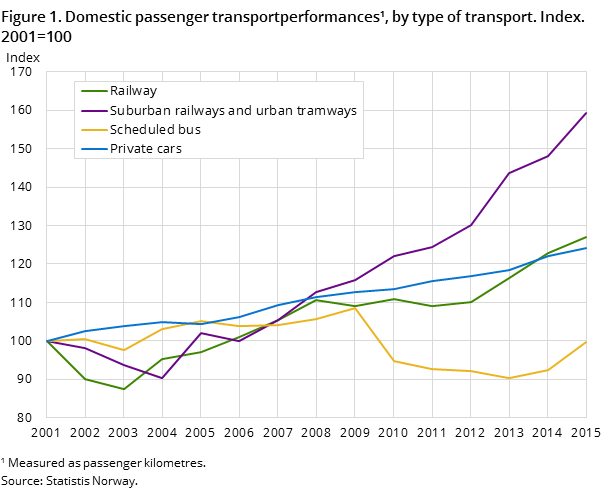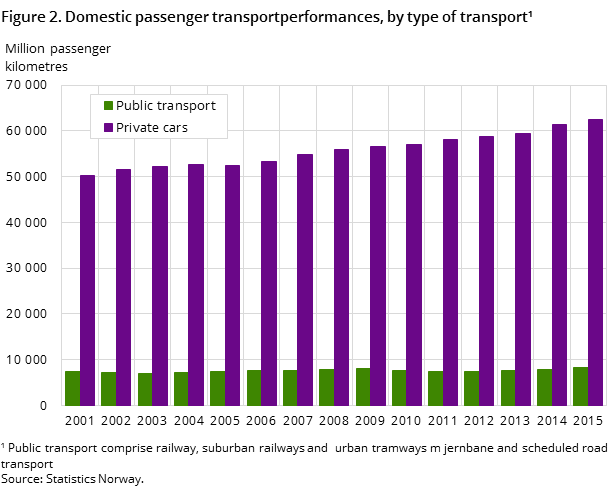Public transport has greatest growth
Published:
From 2014 to 2015, the growth in transport work by public transport was almost 6 per cent. The transport work performed by private cars increased by nearly 2 per cent during the same period.
- Full set of figures
- Domestic transport
- Series archive
- Domestic transport performances (archive)
There has been a significant growth in both the number of domestic journeys and transport work using public transport in recent years. In the five-year period 2011-2015, the number of passengers and transport performance both increased by about 13 per cent to 589 million passengers and 8 410 million passenger kilometres respectively. The growth was particularly strong for urban tramways and suburban railways. The transport work for these modes of transport increased by 28 per cent in the five-year period. By comparison, the transport work for railways increased by 17 per cent and scheduled road transport by 8 per cent in the period 2011-2015. Despite the strong growth in transport work for urban tramways and suburban railways, the percentage of public transport in total is still low, at barely 10 per cent or 810 million passenger kilometres in 2015. The railways accounted for a share of nearly 42 per cent, while scheduled road transport accounted for the remainder (roughly 48 percent).
Average of 33 km was travelled per capita every day by private car
The transport work performed by private cars increased by 1.8 per cent to 62.3 billion passenger kilometres in 2015. This corresponds to a distance of 32.9 kilometres per inhabitant per day on average. Compared to 2001, this was an increase of 2.5 kilometres per inhabitant per day. The average inhabitant travelled 4.4 km per day using public transport in 2015.
New milestone in lorry transport history, with over 20 billion tonnes-kilometres
After the first lorry was registered in Norway in May 1900, it took 96 years before the transport work by lorries passed 10 billion tonnes-kilometres (10.7). In the 20-year period 1996-2015, the transport work doubled to a record 20.5 billion tonnes-kilometres. The increase from 2014 was 3 per cent. A total of 297 million tonnes of cargo were transported domestically by lorry in 2015. This was a decrease of 9 million tonnes, or almost 3 per cent, from 2014. The growth in the transport work in parallel with the reduced amount of goods transported is a result of increased transport length. The average length per tonne increased by 4 km in 2015, to almost 69 km.
Close race between lorry and maritime transport – including cabotage
The domestic transport performance statistics have traditionally comprised domestic transport with Norwegian-registered modes of transport only. This provided a good basis for comparing the respective modes of transport in terms of level and development over time. In recent years, however, a large proportion of goods transported along the Norwegian coast with vessels for hire or reward and on own account registered in the Norwegian Ship Register (NOR) has been taken over by ships registered in foreign registers and in the Norwegian International Ship Register (NIS). Starting with this release, the figures and tables for goods transport are published both with and without cabotage. The time series began in 2010. It shows that vessels registered in NOR performed almost 5.1 billion tonnes-kilometres in 2015, or a quarter of Norwegian-registered lorries transport work in Norway this year. Supplemented by ships registered in NIS and in foreign ship registers, the transport work increased to 19.6 billion tonnes-kilometres in 2015. This represented 94 per cent of the transport performance in Norway by both Norwegian and foreign-registered lorries the same year.
Contact
-
Asbjørn Willy Wethal
-
Vidar Lund
-
Statistics Norway's Information Centre


